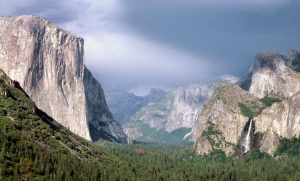Most people don’t often think of national parks, but this week we call attention to one of the greatest groups of natural treasures in the world: America’s National Parks. 
Although we may take for granted that the Grand Canyon is open to the public, Yellowstone’s Old Faithful is protected, and mountains climbers can scale Yosemite’s El Capitan, our natural landscape and historic parks weren’t always managed by a federal agency whose only mission is to preserve these treasures for future generations to enjoy.
In fact, open natural areas weren’t even considered parks, as we know them, anywhere in the world until 1864. It was President Abraham Lincoln that took the first step when he granted the area of Yosemite Valley to the State of California with the conditions that it would be “held for public use, resort, and recreation…inalienable for all time”.
That later led to President Ulysses S. Grant’s designation of Yellowstone as the world’s first National Park in 1871.
Then other parks soon followed. In 1875, Michigan’s Mackinac Island became a national park, but it was later transferred back to the State of Michigan as a state park; Sequoia, General Grant (now Kings Canyon National Park) and Yosemite became national parks in 1890; Mount Rainier in 1899, Crater Lake in 1902, Wind Cave in 1903, Mesa Verde in 1906, Glacier Park in 1910, Rocky Mountain in Colorado in 1915, and Hawaii Volcanoes in 1916.
By 1916, the country needed an agency dedicated to managing and preserving the growing list of national parks. On August 25, 1916, President Woodrow Wilson created the National Park Service to handle the existing national parks and “such other national parks and reservations of like character as may be hereafter created by Congress” and to “conserve the scenery and the natural and historic objects and the wild life therein and to provide for the enjoyment of the same in such manner and by such means as will leave them unimpaired for the enjoyment of future generations.”
Since then, the National Park Service has expanded to be the caretaker of the most iconic and treasured national sites in the country, including 412 national parks, monuments, battlefields, military parks, historical parks, historic sites, recreation areas, rivers and trails, and, arguably the most iconic American site, the White House.
In 2015, over 307 million people visited National Park Service sites. The NPS now has over 20,000 employees and also uses over 200,000 volunteers to help fulfil its responsibility to manage these national resources.
And we here in San Diego are fortunate to have a very popular national park in the Cabrillo National Monument in Point Loma. This weekend, in celebration of the Centennial, all national parks sites, including Cabrillo park will be free to the public, suspending the usual park entry fees.
For those who have not visited this local landmark, the Cabrillo Monument honors the history of 16th century explorer Juan Rodriguez Cabrillo who was the first European to set foot on the West Coast of what is now the United States.
Although Cabrillo sailed for Spain, his exact nationality is still debated by historians. Some think he was Portuguese, some maintain he was Spanish, but either way, he was certainly the first European to land on our coast when his ship stopped in what is now San Diego Bay in September 1542. No European explorer had ever sailed this far North. Cabrillo eventually made his way up the coast past San Francisco, then turned back during a storm.
Cabrillo “discovered” and named several popular bays and islands in California, including Monterrey, San Pedro, Catalina Island, and most famously, San Diego. In November 1542, Cabrillo injured his leg while on Catalina Island and died from an infection in January 1543.
Today, the Cabrillo National Monument commands a stunning location at the tip of Point Loma, overlooking Coronado and all of San Diego Bay. The parks also hosts the original Point Loma Lighthouse built in 1855. When it was operating, the Point Loma lighthouse sat at the highest elevation of any lighthouse in the US. It was retired in 1891 and replaced in service by a lower lighthouse at the foot of Point Loma’s western tip.
This weekend, all national parks are open for free for people across the country to enjoy the natural wonders and historic sites of our National Parks.
For San Diegans, it offers an opportunity to spend a weekend at our local national park for free, enjoying the views and admiring the wonderful city we call home.
Happy 100th Birthday to the National Park Service.
Here’s to many more years to come.